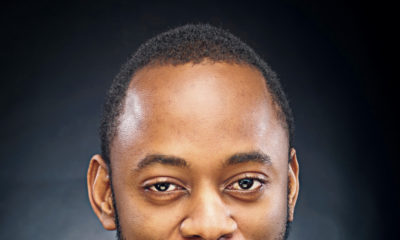Features
Ask Dr. Craig!: Fibroadenoma Or Breast Cancer?
 BellaNaija is pleased to announce a new column for our special readers – ‘Ask Dr. Craig!‘ Dr. Craig is a BellaNaija columnist and one of the doctors who writes for BN Doctors’ Lounge {Get familiar here}. The idea behind ‘Ask Dr. Craig!’ is for BN readers to get quick sharp answers to niggling medical issues that they have. This does not in anyway mean that readers should not go to their doctors. However, sometimes you just need a human face to give answers to those fast, burning medical concerns our readers have.
BellaNaija is pleased to announce a new column for our special readers – ‘Ask Dr. Craig!‘ Dr. Craig is a BellaNaija columnist and one of the doctors who writes for BN Doctors’ Lounge {Get familiar here}. The idea behind ‘Ask Dr. Craig!’ is for BN readers to get quick sharp answers to niggling medical issues that they have. This does not in anyway mean that readers should not go to their doctors. However, sometimes you just need a human face to give answers to those fast, burning medical concerns our readers have.
Send your questions for Dr. Craig to features(at)bellanaija(dot)com stating your full name and where you are writing from. (Your name will never be published) The editor reserves the right to edit submissions for content brevity and clarity. We regret that we cannot provide individual answers to questions sent in and cannot state at which exact date answers would be published.
We hope that people will find help by reading and sharing. We look forward to reading your emails and tweets with questions for Dr. Craig.
***
Dear Dr. Craig,
I am a 27 year old lady and I have had two breast operations after finding lumps. The first was in 2005 when I was nineteen and the other one was last year, and this time in both breasts. Biopsy results in the two instances showed that the lumps were fibroadenomas.
Do I stand a higher risk of getting breast cancer in future as a result of these lumps?
The doctor I saw advised me to get married as soon as possible. Is there any link between fibroadenomas and being single?
Also, in the last few months I have been having severe pains in my right breast. What can this possibly mean? I am so scared of going to the hospital again.
Single-girl. Ikeja, Lagos.
***
Dear Single-girl,
First of all, to answer your last question, allow me point you to a series I ran here on Bella Naija a few months ago on breast health. A lot of the questions about lumps, how to do a self breast examination and what causes breast pain are thoroughly discussed here. {Pink October}
Breast pain can be a pointer to any one of a long list of conditions and it is important that you please see a physician.
So do women who have had a fibroadenoma stand a higher risk of developing cancer later on in life? The answer is ‘not really’. To understand whether there is a link between fibroadenomas and breast cancer, we must first understand how either condition comes about.
Breasts are made up of lobules (milk-producing glands) and ducts (tubes that carry milk to the nipple), which are surrounded by glandular, fibrous supporting tissue and fatty tissue. Fibroadenomas are formed when the supporting structure of the breast (connective tissue) and ducts grow over the lobule and form a solid lump.
It is believed that this tendency for the supporting tissue to form lumps is caused by the fluctuating levels of hormones in a woman’s body during her monthly cycle. Early in the cycle the female sex hormones are at a resting level and the breasts are also at their resting size. As the cycle progresses the body produces more and more sex hormones and these cause the breast to remodel and change in shape and size. As the cycle ends the hormonal levels drop off to normal and the breast also returns to its normal size. This increase and decrease and increase and decrease happens over and over again over many months and years and in some women who are particularly susceptible, this consistent modelling and remodelling of the breast tissue is what leads to the lump formation.
There are two broad categories of fibroadenomas. Simple Fibroadenomas are mainly just connective tissue cells that clump together to form a lump in the breast while in Complex Fibroadenomas certain factors may cause the lump to become calcified or have other different kinds of cells in them apart from connective tissue and may have cysts in their centre.
On the other hand, for breast cancer to develop in any woman there must be cell damage and DNA mutation. This cell damage can be as a result of radiation, or foods or chemicals or even hormones. Every cell has a life span. It stays alive for a specified period of time after which it must die. Before it dies it will divide into daughter cells who will take over its function. So for example, before a cell in your eye dies, it would have made daughter cells who will continue its ‘seeing’ function after it is gone. When a cell gets damaged it can no longer carry out its intended function and so it is removed by the body’s ‘police’ so as to keep the whole tissue healthy and working at optimal level. Sometimes however a damaged cell may evade the body’s police and can go undetected, especially in tissues where there is a very rapid turnover of cells. These damaged cells can then go ahead and form daughter cells who go ahead and form other daughter cells. The resulting mass of abnormal cells is called a cancer. (Please note that cancer formation is a complex multi-layered process. I have over simplified here for the purpose of comparison only)
From the above it is easy to see that by and large, there is NO connection between a fibroadenoma and breast cancer per sė and almost all women with a simple fibroadenoma will NOT progress to have breast cancer.
That said however, researchers have found that even though the processes that cause a fibroadenoma to form is significantly different from those that cause cancer, there may be a very small increase in the chance of developing cancer in women who have had complex fibroadenoma. This is because the conditions that may allow a simple fibroadenoma progress to a complex one are similar to those that can encourage damaged cell proliferation. It is important to reiterate that the process of cancer formation is complex and multifactorial and this similarity is only one of many steps that can lead to possible cancer formation.
As to getting married as soon as you can, I do not see how this would make any difference. Fibroadenomas are hormone dependent and the only realistic way to reduce the likelihood of them occurring is to reduce the hormonal levels. This is why as a woman gets older and as her hormonal levels begin to drop, the number of fibroadenomas also reduce in equal proportion. Studies have shown that the peak age of patients who have fibroadenomas is 30 after which the numbers begin a steady decline. So if you are not in a serious and committed relationship, please don’t rush out to marry the next guy that says hello. Doctors Orders!
All the best with everything
Warm regards,
Dr. Craig
***Disclaimer: This column is written for patient education. It is not intended to diagnose or prescribe treatment and does not replace the advice of your physician. It in no means attempts to cover the full medical scope of this condition.























